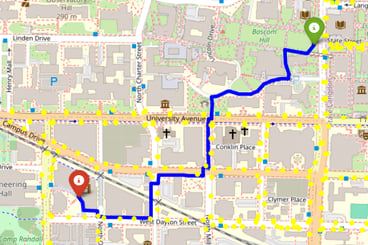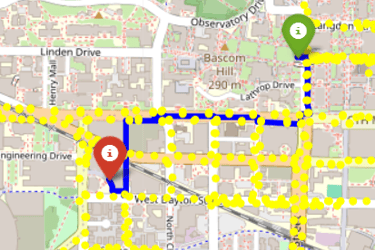Results
After running our model with different values of the trade-off parameter alpha (α), we observed how the selected walking path changes based on whether we care more about short distance or better lighting.
We tested three values of alpha:
α = 0.0: Focus only on the shortest path, ignoring lighting
α = 0.5: Balance distance and lighting equally
α = 0.9: Strongly prioritize paths with more lighting
A. Comparison Table
Here’s how the results compare across these three scenarios:
As we increase α, the model chooses safer paths with more streetlights, even though they are slightly longer.
B. What Do These Results Mean?
With α = 0.0, the model picks the shortest route, but it only has 13 streetlights, making it potentially less safe.
With α = 0.5 or 0.9, the route gets longer by about 115 meters, but has 35 lamps, offering much better lighting and a greater sense of safety.
Even a small increase in distance can lead to much safer walking conditions, especially at night.
This tradeoff is important: a slightly longer path could greatly reduce the feeling of risk, especially for people walking alone.
C. Route Visualizations
Below are two map views showing the different paths generated by the model:
Route for α = 0.0 (Shortest Route)
Blue line: the selected path
Green marker: Start
Red marker: End
Yellow dots: streetlights
Route for α = 0.5 or α = 0.9 (Safer Route)
The model selects a better-lit path, while still maintaining a reasonable travel distance.
D. Limitations
Our lighting-based model uses the number of streetlights along each path as a safety indicator. However, there are some limitations:
We don’t know whether each streetlight is actually working or how bright it is.
We also don’t include other light sources like building lights, storefronts, or homes, which may affect real-world brightness.
If more detailed lighting data (like average brightness levels) were available, we could create an even more accurate model — but such data is hard to find and often not public.





